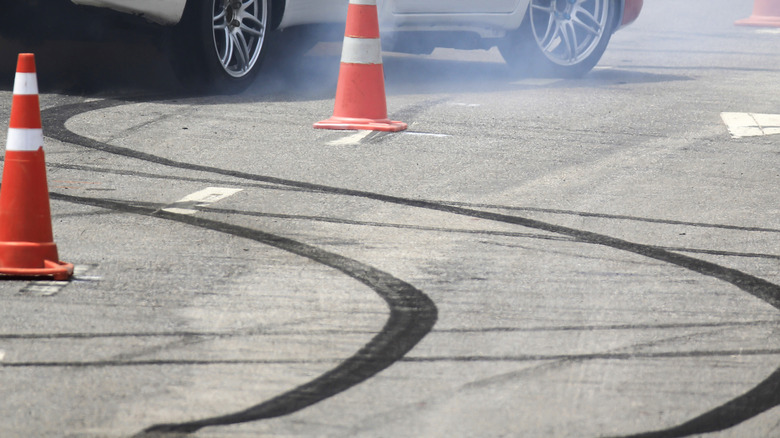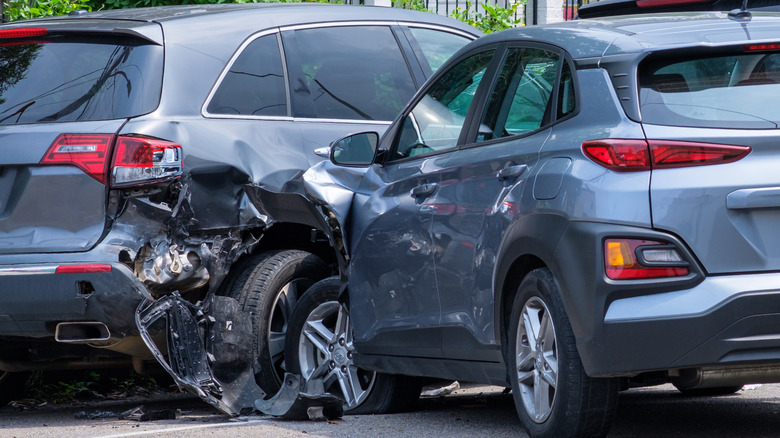

The Emergency Braking Tech U.S. Safety Regulators Say All Vehicles Should Have
source link: https://www.slashgear.com/1301504/emergency-breaking-tech-regulators/
Go to the source link to view the article. You can view the picture content, updated content and better typesetting reading experience. If the link is broken, please click the button below to view the snapshot at that time.

The Emergency Braking Tech U.S. Safety Regulators Say All Vehicles Should Have

As part of a larger initiative by the Biden administration to reduce the nation's rate of traffic fatalities and injuries, the U.S. National Highway Traffic Safety Administration (NHTSA) announced a Notice of Proposed Rulemaking that would make automatic emergency braking (AEB) technology a requirement on all passenger cars and light trucks manufactured for sale in the United States.
When implemented in a vehicle, AEB technology uses sensors, software, and other systems to automatically apply the brakes when it detects an imminent crash, or apply stronger braking if it determines the driver is not manually braking hard enough. The rule proposed by U.S. safety regulators comes after data suggests that AEB technology mitigates the severity of crashes and can potentially save many lives.
According to NHTSA Chief Counsel Ann Carlson, "We've seen the benefits of the AEB system in some passenger vehicles already even at lower speeds, and we want to expand the use of the technology to save even more lives."
The new proposed rule would require AEB in vehicles moving up to 62 miles per hour, as well as requiring the tech to also work in low-light conditions at night. The regulation would currently apply to all U.S. vehicles with a gross vehicle weight rating of five tons or less, which is nearly all light automobiles in the country. If the rule is adopted, car and truck manufacturers will have three years before the AEB requirement takes effect.
Automatic emergency braking could save lives

In the announcement, NHTSA Chief Counsel Ann Carlson added, "This proposed rule is a major safety advancement," which gets to the heart of why the Department of Transportation is looking to require AEB technology in the first place. If adopted, it's expected to dramatically limit pedestrian-involved and rear-end crashes in the United States.
Projections by the NHTSA estimate the rule would lead to AEB systems saving at least 360 lives per year — nearly one a day — as well as reduce injuries by at least 24,000 per year. Because so many crashes would be less destructive or completely avoided altogether, AEB technology would have a ripple effect in other ways. This includes reducing traffic that occurs in the aftermath of crashes, as well as freeing up first responders for other emergencies, as well as property damage resulting from rear-end crashes being significantly reduced.
The impact AEB could have is exactly why the Department of Transportation is pushing for the proposed regulations. Regarding the NHTSA's announcement, U.S. Secretary of Transportation Pete Buttigieg said, "Today, we take an important step forward to save lives and make our roadways safer for all Americans." Recalling prior government regulations, he added, "Just as life-saving innovations from previous generations like seatbelts and airbags have helped improve safety, requiring automatic emergency braking on cars and trucks would keep all of us safer on our roads."
The proposed rule is part of a larger initiative

The push to implement automatic emergency braking on a large scale is part of a larger initiative by the Biden administration to address the high rate of serious crashes on U.S. roads each year. In January 2022, the Department of Transportation launched the National Roadway Safety Strategy (NRSS) to study vehicular accidents and find ways to reduce incidents. This includes a "safe system approach" that uses multiple approaches to address the issue, including building safer vehicles.
A provision in the Bipartisan Infrastructure Law signed by President Biden in 2021 requires regulations that will establish all passenger vehicles manufactured for sale in the U.S. utilize AEB technology to reduce crashes. The Department of Transportation has also produced a Vulnerable Road User Safety Assessment and Complete Streets Report to determine the scope of the problem, as well as issued a rule on rear impact guards.
Other reports have been generated to specifically study pedestrian automatic emergency braking technology, and a Standing General Order was issued to study crashes involving automated driving systems and advanced driver assistance systems.
The DOT has been able to accomplish this thanks to funding from the Biden Administration and the Bipartisan Infrastructure Law. Over $800 million in grants have been issued to communities to address high-crash areas and launch a Call to Action campaign regarding U.S. road safety. If adopted, the new automatic emergency braking regulations will be a major component of the Department of Transportation's push to reduce vehicular crashes and save lives.
</article
Recommend
About Joyk
Aggregate valuable and interesting links.
Joyk means Joy of geeK